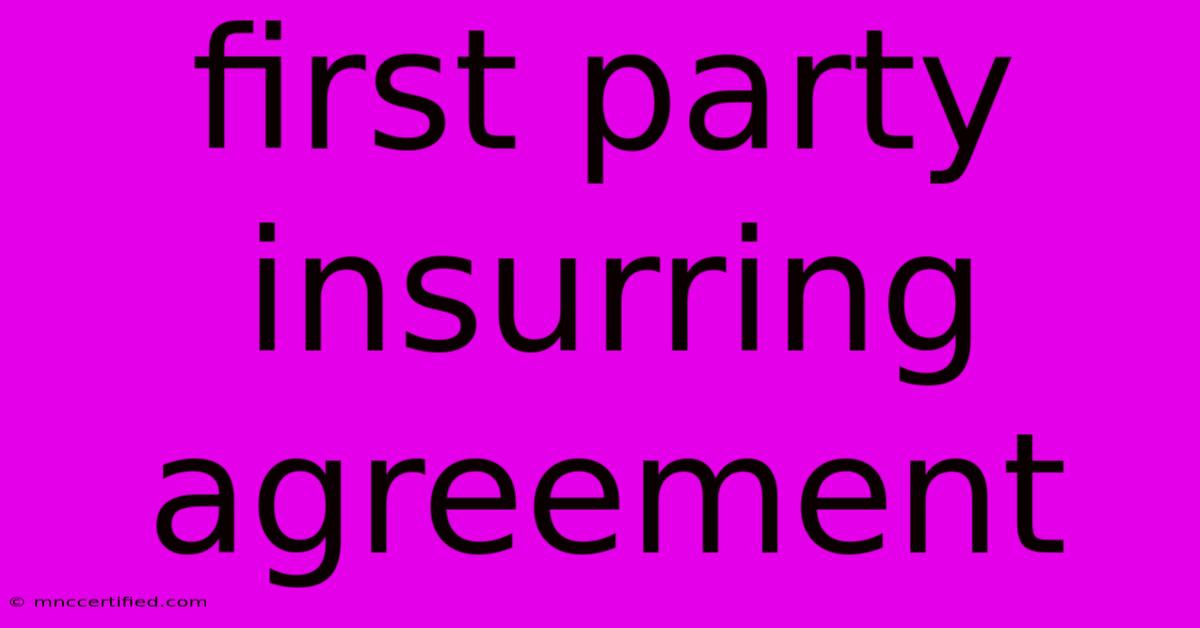First Party Insurring Agreement

Table of Contents
Decoding the First-Party Insurance Agreement: A Comprehensive Guide
Understanding your insurance policy is crucial, and nowhere is this more important than with first-party insurance agreements. These agreements, often overlooked in the rush to secure coverage, dictate the relationship between you (the insured) and your insurance company in the event of a covered loss. This comprehensive guide will break down the key aspects of a first-party insurance agreement, empowering you to navigate claims confidently.
What is a First-Party Insurance Agreement?
A first-party insurance agreement is a contract between you and your insurance provider. Unlike third-party agreements (which cover your liability to others), a first-party agreement covers your own losses or damages. This means the insurer is obligated to compensate you for covered events, such as damage to your property or vehicle, or medical expenses resulting from an accident.
Think of it this way: if your house burns down (a covered peril), your first-party insurance policy will provide the funds to rebuild it, according to the terms of your agreement. This contrasts with a third-party policy, which would cover damages you caused to someone else's property.
Key Components of a First-Party Insurance Agreement:
- Insured: You, the policyholder, and potentially others named in the policy.
- Insurer: The insurance company providing coverage.
- Policy Period: The timeframe the coverage is effective.
- Coverage: Specific perils or events covered (e.g., fire, theft, accidents). This section often includes exclusions – events or situations not covered by the policy.
- Premiums: The payments you make to maintain coverage.
- Deductibles: The amount you pay out-of-pocket before the insurer begins coverage.
- Limits of Liability: The maximum amount the insurer will pay for a covered claim.
- Conditions: Stipulations the insured must meet to maintain coverage or file a claim (e.g., providing prompt notification of a loss).
Understanding Your Policy: Key Clauses to Look For
Reading your policy thoroughly is essential. Pay close attention to these crucial clauses:
1. Definition of Covered Perils: This clearly outlines the events the policy covers. Understanding the specifics is crucial for avoiding disputes later. Look for ambiguity and seek clarification if needed.
2. Exclusions: Know what isn't covered. Common exclusions include acts of God (earthquakes, floods, in some cases), intentional acts, and wear and tear. Understanding these limitations is vital.
3. Duty to Mitigate Losses: This clause typically requires you to take reasonable steps to minimize damage or loss after an incident. Failing to do so could impact your claim.
4. Claims Process: This outlines the steps you must take to file a claim, including required documentation and timelines. Familiarizing yourself with this process beforehand will streamline the process during a stressful event.
5. Arbitration or Mediation Clause: Some policies include clauses specifying dispute resolution methods. Understanding these options is beneficial should disagreements arise.
Navigating a First-Party Insurance Claim
Filing a claim can be daunting, but understanding your policy empowers you. Here's a general process:
- Report the incident promptly. Timely reporting is critical for most policies.
- Gather necessary documentation. This might include photos, police reports, and repair estimates.
- Submit your claim according to your policy's guidelines. Follow the outlined process carefully.
- Cooperate fully with the insurer's investigation. Provide all requested information and be readily available.
- Negotiate if necessary. If you disagree with the insurer's assessment, be prepared to negotiate or seek further assistance.
Seeking Professional Help
If you're struggling to understand your first-party insurance agreement or facing difficulties with a claim, don't hesitate to seek professional help. An insurance attorney or an independent insurance adjuster can provide invaluable guidance and support.
Conclusion: Proactive Policy Understanding for Peace of Mind
A first-party insurance agreement is a critical contract safeguarding your financial well-being. By carefully reviewing your policy, understanding its key components, and knowing the claims process, you can ensure you're adequately protected and prepared to navigate any unforeseen circumstances confidently. Remember, proactive understanding is the best defense against unexpected losses.

Thank you for visiting our website wich cover about First Party Insurring Agreement. We hope the information provided has been useful to you. Feel free to contact us if you have any questions or need further assistance. See you next time and dont miss to bookmark.
Featured Posts
-
Redicks Honest Lakers Game Take
Nov 23, 2024
-
Kirkland Bottled In Bond Review
Nov 23, 2024
-
Suspect Package Gatwick Airport Arrests
Nov 23, 2024
-
Forest Park Jfk Memorial
Nov 23, 2024
-
Aerodrome Coin Price Prediction
Nov 23, 2024